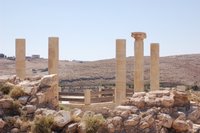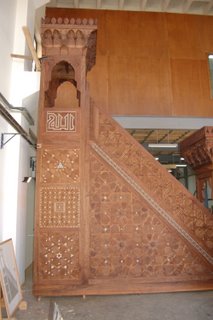On July 12th, we set out for Mukaiwer by bus.  This picture was taken at our stop with the Dead Sea in the distant background. This site was a Roman on the top of a hill/mountain.
This picture was taken at our stop with the Dead Sea in the distant background. This site was a Roman on the top of a hill/mountain.
From the left: Julie, Rana, Efrain, Lil, Me, Cindy, Jane, Will, Paul, Matt, and Darren. A great group of people from coast to coast and Puerto Rico.  We next moved to Um Al Rassas which was a large site that has been partially unearthed. The ruins of Um Al-Rassas lie near the Kings' Highway, 30 kilometers south east of Madaba, in a barren desert, no longer the lush fertile terrain it was during the Roman rule, as described by the Jewish historian of the time, Josephus. The biblical name of this town, Kastron Mepha'at, is mentioned in Joshua 13:18 and in Jeremiah 48:21.
We next moved to Um Al Rassas which was a large site that has been partially unearthed. The ruins of Um Al-Rassas lie near the Kings' Highway, 30 kilometers south east of Madaba, in a barren desert, no longer the lush fertile terrain it was during the Roman rule, as described by the Jewish historian of the time, Josephus. The biblical name of this town, Kastron Mepha'at, is mentioned in Joshua 13:18 and in Jeremiah 48:21.
The Roman fortress, originally a Nabatean city, is a square walled town with very high walls supported by towers. A 15-meter tower stands in the middle and has generated a much speculation on the purpose it served. http://www.jordanbeauty.com/UmAlrassas.html The site had been destroyed by the earthquake from around 740 C.E. There were some beautiful mosaics found inside from an old Byztine church.  These Mosaics were very large and intricate telling about the times with elaborate symbolism.
These Mosaics were very large and intricate telling about the times with elaborate symbolism.
Our next stop was Karak Castle. It was one of the Crusader castles. http://www.vkrp.org/studies/historical/town-castle/ The castles symbolize to Arabs from the area the violence and massacres carried out by the crusaders. The crusaders when they conqueored a town would kill everyone including children sometimes by decapitating everyone. To them an Arab life was worth less than a Christian's life. Some think they see parallels in Lebanon when one Israeli soldier is killed the response is that 100 Arabs must die. The legacy of the crusades is why there was such an uproar when President Bush talked of his invasion of Iraq as a crusade.

The castle is located on top of a mountain peak with deep valleys on all sides. There was a moat and drawbridge.

This shows how steep the sides the castle were for anyone approaching.
 This country has a lot of police. This one specializes in policing tourists outside of Kurak.
This country has a lot of police. This one specializes in policing tourists outside of Kurak.




























